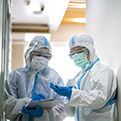
Getty Images / tuachanwatthana
2020’s top 5 COVID-19 articles in The Journal of Applied Laboratory Medicine reflected key topics of importance to the clinical laboratory community, with articles and commentaries on assays’ effectiveness, the association between severe COVID-19 illness and routine lab tests, and preserving safety in clinical labs.
Screening the General Population for SARS-CoV-2 Virus and COVID-19 Antibodies: A Counterargument earned the distinction as the most-read COVID-19 article in JALM. Alan Wu, PhD, director of clinical chemistry and toxicology at the University of California, San Francisco, made the case against mass screening of the general population using the current virus and antibody assays. “In the haste to produce a COVID-19 antibody test and the relaxing of [Food and Drug Administration] approval through the emergency use authorization, the quality and reliability of these assays may be substandard,” cautioned Wu in his commentary.
If you’re going to mass screen, antibody tests might be a viable approach because it would widen the scope of SARS-CoV-2 detection. Serum antibodies tests are also easier to collect and test for than molecular tests, he added. “Moreover, point-of-care antibody testing devices are available that can produce results within 15 minutes from a fingerstick blood sample. However, the sensitivity of antibody tests will need to be high for this approach to be successful,” cautioned Wu. In September, Wu reiterated his concerns about mass testing, claiming that antigen and other rapid tests are too inferior to be effective.
The race to mass test individuals is unlikely to slow down, he acknowledged. Several top articles looked at the efficacy of specific assays.
Longitudinal Monitoring of SARS-CoV-2 IgM and IgG Seropositivity to Detect COVID-19 evaluated the performance parameters of the Diazyme SARS-CoV-2 IgM/IgG serology assays, using a cohort of 54 polymerase chain reaction (PCR)-positive patients and 235 negative samples. For IgM, IgG, and IgM/IgG respectively, the assay yielded sensitivities of 89.5%, 94.7%, and 100% for detecting seropositivity at ≥15 days following a positive SARS-CoV-2 PCR result. Specificity was also high, at 99.6%, 99.1%, and 98.7%, respectively for IgM, IgG, and IgM/IgG panels. “Serology testing should be considered a complementary test to support PCR testing to aid in the detection of asymptomatic cases and is useful for documenting previous exposures to SARS-CoV-2,” the authors concluded.
Clinical Validation of a SARS-CoV-2 Real-Time Reverse Transcription PCR Assay Targeting the Nucleocapsid Gene described the clinical development of a real-time PCR molecular assay to detect the virus. In the early weeks of the pandemic, live or attenuated SARS-CoV-2 was not available to most clinical laboratories developing tests. As an alternative, clinical laboratories used purified genomic SARS-CoV-2 RNA. When testing the entire assay system including extraction, dilutions of purified RNA would degrade in the re-extraction process. This clinical validation demonstrated the utility of combining lysis buffer with clinical matrix before adding RNA. In addition, endemic coronavirus controls were used to optimize the extraction process. This assay validation was sufficient to meet the FDA criteria for emergency use authorization.
Moving from individual tests to the big picture, Laboratory tests and outcome for patients with COVID-19: A systematic review and meta-analysis analyzed 21 studies to assess the association between routine lab tests and severe disease. Higher levels of the following markers indicated disease severity in COVID-19: white blood cell count, neutrophil count, C-reactive protein, lactate dehydrogenase, D-dimer, and aspartate aminotransferase. Low levels of lymphocytes, platelets, and hemoglobin also signified severe disease.
Another article looked inward on labs, addressing safety issues in their operations. A Laboratory Risk Assessment during the Coronavirus (COVID-19) Pandemic urged labs to conduct a biologic risk assessment to protect workers from occupationally acquired infections. James H. Nichols, PhD, DABCC, FADLM, and Carol A. Rauch, MD, PhD, of Vanderbilt University School of Medicine, also recommended frequent handwashing, disinfecting high-contact surfaces, wearing of personal protective equipment, and taking steps to minimize aerosol-generating procedures. Labs need to individualize risk and biosafety measures to their workflow and specimen management, advised Nichols and Rauch.
Through early October, JALM and Clinical Chemistry had published 43 articles reflecting rigorous research related to SARS-CoV-2, different testing methods, and related analyses as well as views and experiences of the global lab community in developing and implementing tests and in dealing with operational demands of the pandemic.
Collectively, as of early October this content had been downloaded more than 112,000 times, shared about 1,000 times, and cited in 220 other publications. Many of these articles have Altmetric Attention Scores in the top 5% of all research outputs, which indicate the reach and attention received by a publication beyond traditional methods of measuring impact. Both journals, in cooperation with Oxford University Press, have made COVID-19 content freely accessible to assist researchers, medical professionals, policymakers, and others who are working to diagnose, treat, and discover more about SARS-CoV-2.